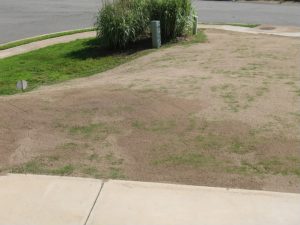
The benefits of topdressing your lawn…grow grass like a champ!!!
January 13, 2017
If you live here in Georgia and tried to grow any type of plant, then you know about our notorious Georgia red clay (dun-dun-duhhhh).

It is beautiful but too often the contractor grades out your home and at the same time strips the topsoil, leaving only the poor sub soil behind. Don’t worry, it was left totally compacted too by the time the house was completed. Last but not least your poor sod gets thrown on top of the nutrient and organic matter deficient, compacted dirt. Good luck trying to keep your lawn healthy. It will take more water, nutrients, herbicides, pesticides, and more to keep it looking up to par.
If by chance you actually do have good soil beneath your turf, keep reading because topdressing will maintain the healthy lifestyle of your turf. After all, good soil conditions are like similar to living a balanced lifestyle ourselves. When you have the proper nutrition, water, and exercise then you will look and feel better and have less weeds in your life. It’s more work to get poor soil back into shape than to start with it from the beginning but topdressing can help in either situation.
Just like other plants your lawn turfgrass needs light, air, and water. A deep healthy rootzone helps the plant thrive even through stressful conditions, such as a drought or extreme temperatures.

Unfortunately, compacted soils with a high clay content (the typical stuff around here) make it difficult for roots to penetrate deep into the soil (which lacks nutrients and water anyway). You can take a sample by cutting out a small patch with a shovel or knife. If you notice the roots are less than a few inches we need to to help them out. The compacted clay also prevents air and water from infiltrating into the soil so only the top portion of the soil gets any moisture before the excess water just runs off the lawn.
The second issue that plagues turfgrass, especially healthy lawns, is thatch build up. Thatch is basically decomposing organic matter developed by old stolons and rhizomes from turf growth. It’s important to note that grass clippings do not contribute to thatch, so don’t worry about that. Thatch collects between the leaves (green part) and the roots, so you really don’t see it without digging down to look at a sample of turf. Too much thatch actually prevents water and air from getting through and down to the roots.

Soooo, two things prevent water (along with nutrients) and air getting deep into the soil where it can last for days to continue to last between rainfall (or irrigation events). Those two things are compacted clay soils and thatch. The solution is to core aerate and topdress.
Core aeration pulls plugs of dirt and thatch out of the profile and leaves them up on top. Topdressing with sand [why use sand? read this] provides an amendment that reduces compaction and allows water and air to go deep into the soil. Dragging the plugs back into the turf while you drag the sand is fine. The additional air getting to the rootzone will help the excess thatch decompose properly as well. Dethatching is another process that may be required if thatch is too excessive.

As you may already know, you should only cut your grass no more than a third of its height at a time. Often you break this rule when your lawn is not level and has humps or holes. When the mower goes over these rough areas it scalps (cuts the grass too low) the grass and leaves only the tan/brown stems with no green leaves. It looks terrible and is not good for the turf health either. Topdressing in these areas smooths it up so that you are left with an even cut every time and sweet green grass. You know the kind you look out the window and say wow look at my lawn!
If you are ready to get started or have questions please feel free to contact River Sand, Inc. for help.

